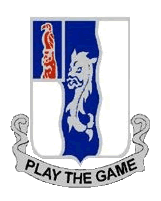
Steel Pot Pouri I: Tough Love
Copyright 2002: Richard Guthrie. All rights
reserved. (copy permission at bottom)
Webmaster's Introduction Dick Guthrie, company commander of B Company, 1st Battalion (Mechanized), 50th Infantry from September 1967 to January 1968 takes a brief look at an often unappreciated piece of equipment, - the Helmet, Combat, M1 with the plastic Liner, Helmet , M1 introduced in 1964, commonly known as the "steel pot". From it's introduction in WWII, the M1 helmet was constantly upgraded and improved. The helmet was a piece of gear that every grunt in Vietnam became intimately familiar with. Of course, it's all now just a part of history, having been replaced since 1983 by the current P.A.S.G.T. (personnel armor system, ground troops) ballistic helmet made of Kevlar. |
It no doubt was an improvement over the wide-brimmed one we remember from the newsreels of WWI, but the helmet our soldiers wore in Vietnam in the late 1960's was of a technology already three decades old, and it left a lot to be desired.
Men can adapt to almost anything, and a couple of pounds on the head would not seem too much. Nonetheless, unlike combat boots or a fifty-pound rucksack, you simply never got used to wearing your "steel". In addition to the discomfort it caused by being too heavy, too cumbersome, it also became an oven in the searing, humid air that blanketed us much of the time. The inside harness had several adjusting points available, with infinite possibilities to make it fit tighter or looser, or ride higher or lower, but no setting ever made it painless or functional. The thing would flop around or fall off if you left the sweatband comfortably loose, but it would give you a throbbing headache if you adjusted it tight enough so that it would stay on. The chin strap had been modified several times in the ten years I had been in uniform, but it never actually got to where you'd keep it fastened of your own free will, except when you jumped out of an airplane. So the "steel pot" would fall off -- so to speak -- at the "drop of a hat" and it made a loud noise when it banged on rocks after branches or mere gravity pulled it from the precarious perch it was expected to protect.
Problems with the pot were real enough, but in Company B, we all got a look at the crease left in Bulloch's helmet by the grazing AK-47 round in our initial exchange of fire with the enemy. We knew firsthand that the helmet did save his life and could save others, so we wore the "steel". And I enforced that policy pretty rigidly.
As with any piece of Government Issue (G. I.) gear, the users were quick to devise a number of alternative uses for their steel pot. The most obvious was as a washbasin. With practice you learned to take a fine whore's bath from a helmet full of questionable water drawn from a nearby rice paddy. But the pot also served other purposes. It made a pretty good pillow if you were tired. It was waterproof and there was room to tuck a pack of cigarettes between the webbing and the interior dome. Stored there, the smokes would get soggy from the condensation and sweat, but as long as you didn't drop your pot in a deep puddle or flooded paddy, they usually wouldn't get so soggy you couldn't light one with your trusty Zippo lighter first chance you got. Many soldiers also used the inside of the pot to keep a cherished photograph of girl friend or wife and children near at hand.
The camouflage cover was held in place by an olive drab elastic band which, rain or shine, was an ideal place to tuck the small plastic bottle of issued mosquito repellent. And the cover made a fine billboard where the troops felt free to express themselves:
"Wheeling, West, By God, Virginia"... "Charlene"... "Tifton, Georgia"... "F.T.A."... "Rocky Bottom, S. C."... "Fighting for Peace is like screwing for chastity",,, "Maricarmen"... "Kill Commies"...
Most soldiers, when they were within ninety days of their rotation date, would painstakingly print some form of "Short-timer's calendar" on the camouflage cover. Then, with great ceremony, they would cross out a number at the start of each day, so everyone knew just how short they were, how many days remained in their tour.
It is not difficult to understand how some commanders, loving their troops, gave in to their complaints and permitted the baseball cap, or the "bush" hat out in the field. It is not an oversight that, in the statue at the Vietnam Memorial, only one of the three soldiers even has his helmet -- in his hand -- but none is actually wearing one.
In Alexandria, Virginia in 1997 at a reunion marking the thirtieth anniversary of our battalion's arrival in Viet Nam, a man nearly my age approached me.
"Cap'n, you may not remember me, but I sure do remember you", he said. "One time I was coming back to the company from the hospital. I climbed off the evening resupply bird wearing my soft cap, and it was all over. You gave me an Article Fifteen; fined me two weeks pay. I really don't hold it against you at all. I knew better, and I had that coming."
I confess that I had not the slightest recollection of that specific incident, and still don't. But I'd feel bad if I thought the account were not true.
Maybe mine was a tougher sort of love.

Copyright 2002 Richard Guthrie,
RPGUT3@aol.com
This article may not be downloaded, copied or used in any manner without the expressed written permission of the author.